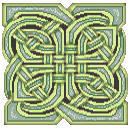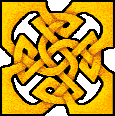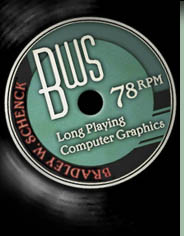
Most
of the designs in this collection are Celtic knotwork, or
Celtic interlace, patterns. Interlace is one of the most identifiable
aspects of Celtic art although it’s a relatively late
addition to the repertoire of the Celts.
 From
the Bronze Age forward Celtic art embodies a very well-developed
use of form. This is especially evident in the curved and
sweeping shapes Celtic craftsmen delighted in creating -
sometimes abstract, sometimes stylized from plant or animal
forms. The exact point at which this mastery of line and
shape first adopted interlace as its main expression is
not clear, though it probably developed between the early
christian period and the seventh century C.E. From
the Bronze Age forward Celtic art embodies a very well-developed
use of form. This is especially evident in the curved and
sweeping shapes Celtic craftsmen delighted in creating -
sometimes abstract, sometimes stylized from plant or animal
forms. The exact point at which this mastery of line and
shape first adopted interlace as its main expression is
not clear, though it probably developed between the early
christian period and the seventh century C.E.
The
early Celtic church diverged very markedly from christianity
as practiced on the continent. Its manifestaion as a loosely
organized community of monastic orders or communes in the
wilderness reflects not only pagan Celtic tradition (in which
groves and springs were sacred places) but also resembles
the early christian society of North Africa. Interlace was
used by the Coptic communities in North Africa, though it
was never developed there so well as it did in the British
Isles. It is possible that it was this heretical link which
brought knotwork to the islands where it was to become known
universally as "Celtic Interlace"; but on the other
hand, this type of ornament is native to many parts of the
world, including China, so there’s also the possibility
that it developed locally.
 Another
influence, less well understood, is is that of the Picts in
what is now Scotland and northern England. These are a people
slighted by history, often portayed as naked stone-age fellows
chipping flints in their burrows: in fact there seem to have
been organized and powerful kingdoms of these Coritani or
Cruithne well into the ninth century, able to withstand the
many waves of invaders who came to their territories. Their
stone monuments are among the most excellent examples, both
in design and craftsmanship, of interlace and animal ornament.
While the period references for a study of the Picts are inconclusiveone
can still hope that we’ll know more about them one day. Another
influence, less well understood, is is that of the Picts in
what is now Scotland and northern England. These are a people
slighted by history, often portayed as naked stone-age fellows
chipping flints in their burrows: in fact there seem to have
been organized and powerful kingdoms of these Coritani or
Cruithne well into the ninth century, able to withstand the
many waves of invaders who came to their territories. Their
stone monuments are among the most excellent examples, both
in design and craftsmanship, of interlace and animal ornament.
While the period references for a study of the Picts are inconclusiveone
can still hope that we’ll know more about them one day.
There
were also strong related traditions for decoration in Scandinavia.
A recurring motif in early Saxon and Scandinavian art is the
gripping beast, and bands of interlaced ornament are also
frequently found in those parts.
 It’s
important to remember the nature of the age in which this
art form became dominant in Celtic culture. Between the sixth
and eighth centuries, there was a prolonged and brutal collision
of British, Irish, Pictish and Scandinavian peoples in northern
Britain. During the seventh century these four cultures wrestled
for territory with such violence that all contemporary local
records simply cease - for years. In the generations following
this period it’s apparent that after the wars there was
a cross-fertilization of these cultures that may have resulted
in what we now call Celtic Interlace as well as other developments
including the creation of the frame harp, strung with horsehair
or wire. It’s
important to remember the nature of the age in which this
art form became dominant in Celtic culture. Between the sixth
and eighth centuries, there was a prolonged and brutal collision
of British, Irish, Pictish and Scandinavian peoples in northern
Britain. During the seventh century these four cultures wrestled
for territory with such violence that all contemporary local
records simply cease - for years. In the generations following
this period it’s apparent that after the wars there was
a cross-fertilization of these cultures that may have resulted
in what we now call Celtic Interlace as well as other developments
including the creation of the frame harp, strung with horsehair
or wire.
However
it arrived in Ireland, Scotland, and Wales, the Celtic peoples
lost no time in perfecting interlaced knotwork. This style
of decoration appeared in metalwork, carved stones, textiles,
and, ultimately, in illuminated manuscripts such as the
Books of Kells, Lindisfarne, and Durrow, in which some see
the highest expression of Celtic art. By the time these
manuscripts were made, the Irish ecclesiastics were on familiar
terms with the Saxons of England. Many young Saxons travelled
to Ireland to be educated (the Welsh wouldn’t have
them; in fact, the Welsh christians didn’t even want
to convert them, since they’d then have to share their
Heaven with the Saxons as well as their Earth). If it hadn’t
arrived before, this is probably the origin of the "gripping
beast" in Celtic art - the ancestor of the designs
you’ll find in that section of the present collection.

There
have been various suggestions that interlace patterns form
a sort of language. In the literal sense this is probably
not true. Such a tradition would almost have to predate christianity,
which brought its own form of literacy to the Isles. Not only
is that unlikely due to the physical evidence, but even if
it were so the Druidic and Scandinavian traditions alike avoided
the use of written language for most purposes; our word "spell",
which means both to write a thing or to enchant it, is a Saxon
word that demonstrates how seriously these people took the
act of writing - a creative act tied to the magic of poetry
and to pure enchantment itself. One can’t describe as
"illiterate" a people to whom education meant the
memorization of hundreds of stories, geneaologies, and poems;
in fact the ancient Irish used several hundred poetic metres
and variations alone, which a bard or filidh had to learn;
but "literacy" in the literal sense of "writing"
wasn’t in their curriculum. Any of us, in this age of
printing and now of electronic data transmission, would be
unlikely to master that sort of mental training - but writing,
and specifically the use of knotwork as a means of writing,
looks very unlikely as a branch of Celtic learning.
Another
idea, proposed by John Cargill*, is that Celtic knotwork was in some
cases a form of musical notation. To my knowledge no one has
pursued this idea further, but it’s an interesting one;
basically he believed that a limited number of the stone carvings
in Scotland used a particular freeform type of interlace to
record musical scores.
My
own belief is that interlace embodies one idea. It is the
same basic premise of cartomancy, of astrology, indeed of
all forms of divination: that all things proceed from one
substance, and that all things are composed of various embodiments
of that one thing - a substance, or energy, or conciousness,
whose sentient elements turn and contort themselves is an
effort to see the entire pattern of which they are a part.
In this view the knots and patterns of interlace represent
the complicated whole of creation as the embodiment of one
strand of essence.

An
interlace pattern is a design made up of a band or group of
bands of patternwork which, like a woven thread, pass alternately
over and under one another as it (or they) loop and knot around
one another. This is the only basic rule: that a band alternates,
over and under, throughout the design. That rule is sometimes
relaxed in the case of "gripping beasts" in order
to accent the identifying characteristics of the animal.
For
the purest embodiment of what I’ve proposed as the "idea"
of interlace, the entire design ought to be composed of a
single band. Personally, I don’t always restrict my designs
this way, though I usually try to avoid obvious "rings"
- and the ancient craftsmen didn’t always follow that
rule either.
To
my mind, this should depend on the purpose of the design or
the nature of the object being decorated. For example, a wedding
ring would be a truer symbol if it were composed of two interlacing
bands, rather than one.

The
most widely used source for students of Celtic art is George
Bain’s Celtic
Art: The Methods of Construction.
Bain’s book is a valuable atlas of surviving examples
of Celtic interlace, spiral designs and fretwork. There are
over two hundred designs in the book as well as any number
of variations on them, and he gives reasonable techniques
for constructing and adapting his examples. Where Bain falls
short is is in his text, which honestly is not very good,
and fails to arm the reader with the basis for a really creative
use of the material he presents.
A
second book is A
Handbook of Celtic Ornament
by John G. Merne. Apparently by chance the Merne book is a
perfect companion to Bain’s. Merne introduces the reader
to the fundamental principles of actually creating knotwork
designs, gives examples of increasing complexity for basic
knots and panels, shows techniques for linking these either
as bands or as "carpet" designs, and sends one off
to Do It Alone.
We’re
very fortunate to have both of these books in print. Together
they form a treasury of existing ornament and a craftsman’s
guide to creating both similar and new designs in the traditional
manner. In addition to these two important books there are
others of interest:
Clicking
on the links for in-print books will take you to that book’s
page at Amazon.com; if the book is out of print, I've set
up its links to search for used copies at AbeBooks.com.
Armstrong,
Robert Bruce - The Irish and Highland Harps
Bain,
George - Celtic
Art: The Methods of Construction
Crawford,
H.S. - Irish Carved Ornament
Henry,
Francoise - The Book of Kells
Merne,
John G. - A
Handbook of Celtic Ornament
Stead,
I. M. - Celtic Art In Britain Before the Roman Conquest
*
John Cargill's "The Celtic Cross and Greek Proportion"
in Miscellanea Musica Celtica by J. Travis; Medieval Music
Ltd., New York is not included in the bibiography because
I'm uncertain of the volume number.



THIS PAGE SPONSORED BY


These
designs are all copyright Bradley W. Schenck, 1997 &
1998, but may be used without fee by individuals for
non-commercial web projects. If
you're building your own web site, and you don't make
money from the site, feel free to use these designs.
If you are profiting by building a site for someone
else, do not use them. If you are creating your own
commercial site, do not use them. If
you want to use one of these designs as a tattoo, a
stationery design for your personal email, or want to
make an object for your own use (not for sale) using
one of these designs, go ahead. It
is specifically prohibited for anyone other than the
artist to include these images in a collection of clip
art, whether for profit or not. Got it?
If
you use these designs on your web pages, I would be
grateful for a credit and, if possible, a link to:
http://www.webomator.com/bws.

|

![]()
![]()

